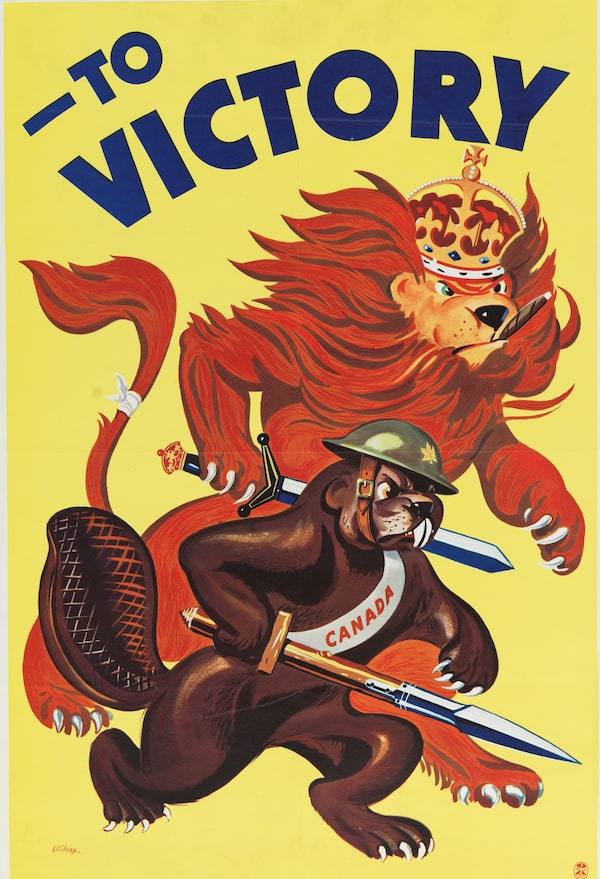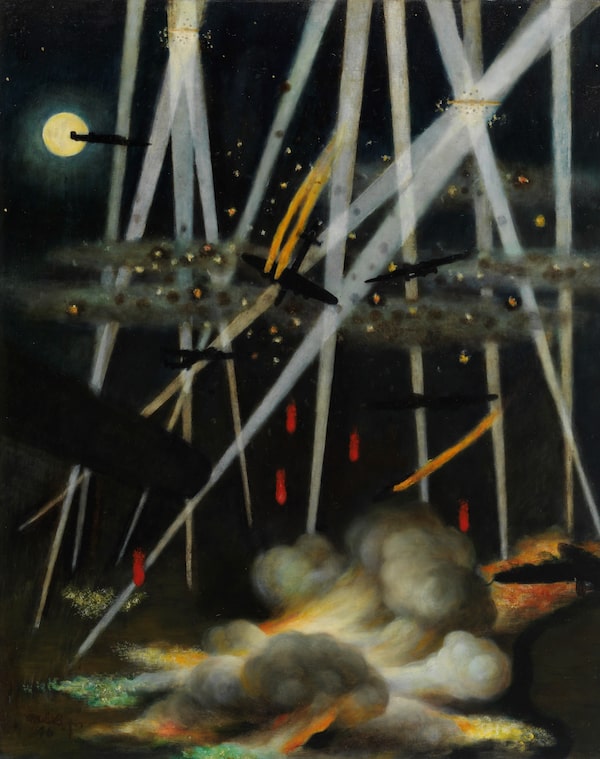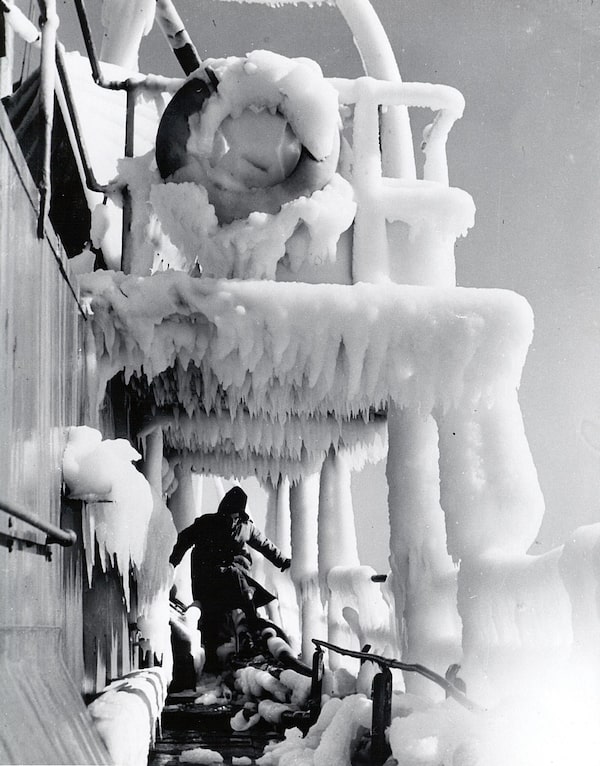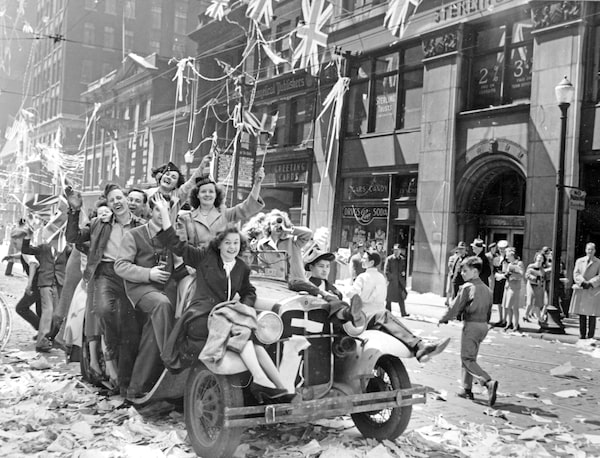Troops from the 4th Canadian Armoured Division liberate Hilversum, the Netherlands, on May 7, 1945.Canadian War Museum (CWM 19920085-1384)
September 2 marks the 75th anniversary of the end of the Second World War. It was ushered in with the signing of the Japanese Instrument of Surrender, as the treaty between the Western Allies and Japan was formally known. The war had been a struggle of monumental proportions, killing some 60 million people, destroying nations, signalling the decolonization of Empires and setting the stage for the Cold War.
As part of the horror, the world was forced to bear witness to the systemized and industrialized murder of six million Jews and other groups like the Roma, homosexuals and the physically and mentally disabled, in what has become known as the Holocaust.
The forces of the Nazi Thousand Year Reich and Mussolini’s fascists oppressed and murdered their own citizens and were threatening the free world. In the face of mass atrocities and unfettered aggression, this war was widely seen as necessary, with total mobilization required to stop the evil regimes.
Canada was forever transformed by its war effort. Almost all 11.5 million citizens were affected, especially the 1.1 million who served in uniform, including 50,000 women.

A wartime poster shows Canada (the Beaver) standing with Britain (the Lion) and ready for battle.Canadian War Museum (CWM 20070104-083)
Only a few thousand were professional military personnel. The majority of men and women from English, French, new Canadian and Indigenous communities left their loved ones and came together in a common cause and enlisted.
The Royal Canadian Navy grew to almost 100,000 strong and, by the war’s end, there were more than 400 corvettes, frigates, destroyers and other warships in support of the Allied war at sea. These warships played a crucial role in protecting Canadian shores, even as German U-boats penetrated the country and sank nearly two dozen ships in the St. Lawrence starting in May, 1942.
Along with the Merchant Navy sailors, the navy’s greatest contribution was braving the gauntlet of enemy U-boats in the North Atlantic that sought to cut supply lines from North America. A heavy price was paid in the Battle of the Atlantic, the longest continuous campaign of the war (September, 1939, to May, 1945), but Canadians relentlessly sailed through and kept Britain in the war.

Night Target, Germany, by Canadian artist Miller Brittain, a Royal Canadian Air Force airman in Bomber Command, shows the stunning beauty and brutality of a bomber strike against European targets.Canadian War Museum (CWM 19710261-1436)
As the war progressed, Germany was winning on every front, and the Allies turned in desperation to their striking arm, Bomber Command. With a growing force of bombers, the Allies smashed German-occupied western Europe. The Germans had started the war by targeting civilians in indiscriminate aerial terror bombing campaigns, especially in industrialized areas such as London, Coventry and Liverpool during The Blitz. But it was the Allies who finished the war with unyielding attacks on almost all enemy or enemy-occupied cities in Western Europe.
Around the world, Canadian army units fought in Hong Kong and Dieppe, France, resulting in significant losses. Individual Canadians served in North Africa and Southeast Asia with British forces, while others served with Allied forces to defeat the Germans and Italians in Sicily in July, 1943. From there, close to 100,000 Canadians battered the dug-in enemy during the long, attritional campaign through mainland Italy.

A Canadian warship encased in ice. In the Battle of the Atlantic, sailors faced harsh seas, frigid weather conditions and a relentless enemy.Canadian War Museum (CWM 19910238-796)
Canadians were also part of the spearhead Allied force on D-Day on June 6, 1944, capturing Juno Beach under heavy artillery, mortar and machine-gun fire. Land and air forces, supported by long-range naval guns, drove the Germans back in the brutal battles of Normandy through the summer of 1944. But the war did not end there. There were more Canadian campaigns along the French coast in September, clearing the Scheldt estuary in October and November, 1944, and finally, breaking the Germans in the Rhineland.
Victory in Europe came on May 8, 1945.
The cost was gut-wrenchingly high, with Canadians buried throughout Western Europe. But as the liberation of the starving citizens of the Netherlands at the end of the war revealed, the long and terrible war was necessary.

People celebrate the news of Germany's surrender on Bay Street in Toronto on May 7, 1945.The Globe and Mail
Canada’s war against Japan was more limited, although approximately 10,000 Canadians served in air force squadrons, wireless listening units and special formations, often consisting of Japanese- and Chinese-Canadians who sowed destruction behind enemy lines.
Almost 2,000 Canadians at the doomed outpost of Hong Kong battled against impossible odds, and the survivors faced unspeakable horror by the Japanese in prisoner of war camps.
The overseas war affected all aspects of life at home, in some instances leading Canadians to turn on themselves. Japanese-Canadians were singled out as disloyal: 23,000 were forcibly relocated from the coast of British Columbia, their private goods sold off at low prices, and some 4,000 were pressured to accept deportation to Japan.
The defeat of Japan, on Aug. 15, 1945, brought an end to the war, with Japan’s formal, unconditional surrender on Sept. 2.
The final victory of the war cost more than 45,000 Canadian lives in total.
Now, 75 years later, the grief no longer burns as brightly, but there remains the throbbing ache of absence: hollowed-out families that never recovered and a country forever diminished by the loss. And for the survivors, the ordeal left many veterans and their loved ones forever changed, with the war imprinting itself in visible and invisible ways.
While most veterans returned whole of body, some 55,000 were wounded. With government care and personal determination, almost all went on with their lives. Chief Justice of Canada Brian Dickson, Minister of National Defence Barney Danson and James Doohan, who played Scotty in the original Star Trek, were just a few who suffered grievous wounds, but still found ways to make significant contributions to society. So did most other veterans, along with the 48,000 war brides, from the Netherlands, France and Britain, who came back from overseas with their Canadian husbands to forge a new country out of the ashes of the war.
The Second World War, by the numbers
- 1.1 million Canadians served in uniform
- 100,00 served in Royal Canadian Navy
- 250,000 served in Royal Canadian Air Force
- Over 500,000 served in the Army
- 50,000 women served in navy, air force, army, and as nurses
- 10,000 Canadians served in Pacific and Southeast Asia
- 45,000 Canadians killed
- 55,000 wounded
- 48,000 war brides
Tim Cook is the acting director of research for the Canadian War Museum and author of 13 books of Canadian military history, including his most recent, The Fight for History: 75 Years of Forgetting, Remembering, and Remaking Canada’s Second World War (Allen Lane, 2020).